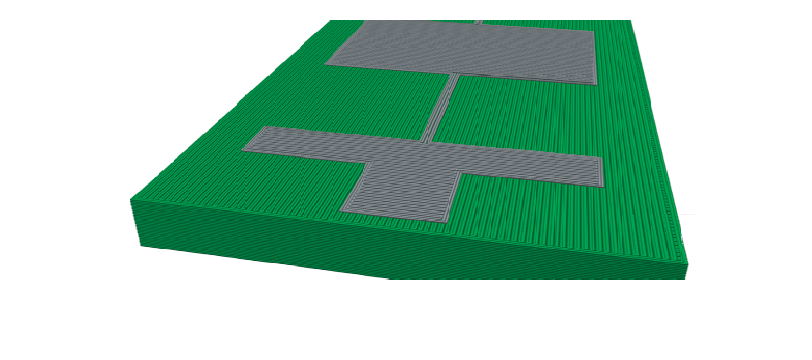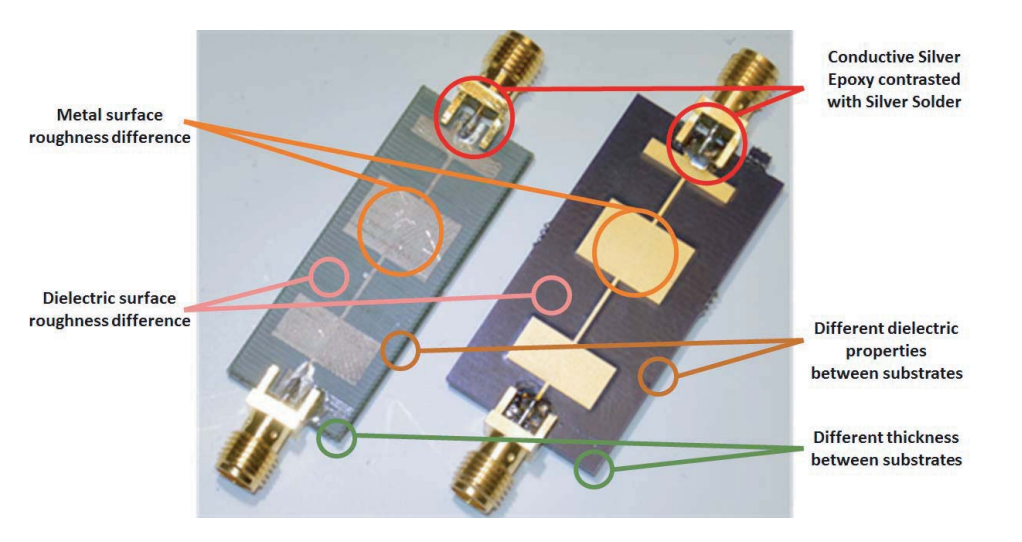In the recently published ‘High-Frequency Filters Manufactured Using Hybrid 3D Printing Method,’ authors Ubaldo Robles, Edgar Bustamante, Prya Darshni, and Raymond C. Rumpf outline the development of two varying devices. In using hybrid 3D printing, they employed both conductive inks and thermoplastic substrates, performing further research regarding the potential of 3D printing technology within electronics, and 3D circuits. They compared basic microwave filters, made both conventionally and via 3D printing.
The two designs are well-known overall, allowing the researchers to make true comparisons that other users interested in electronics can relate to. Filtering signals at 2.4 GHz, the devices were evaluated for performance:
“The conventional filters were manufactured as standard PCBs that utilized copper for the conductors and FR4 as the dielectric substrate. The hybrid 3DP filters had dispensed silver inks to form the conductors and acrylonitrile butadiene styrene (ABS) plastic as the dielectric substrate deposited via fused filament fabrication (FFF),” explained the researchers.
“Hybrid 3D printing was used to merge micro-dispensing and FFF into a single manufacturing process. Using nScrypt hybrid 3D printing technology, we were able to handle 3D printed features, accuracy, and repeatability down to the micron size level. Last, the devices were tested using an Agilent vector network analyzer (VNA), and the results compared show that this technology is able to form simple high-frequency circuits.”
The two designs consisted of a coupled-line bandpass filter and a stepped-impedance low pass filter. The authors explained that both were based on microstrip transmission lines, but with different dielectrics and different permittivity. The researchers adjusted the substrates as they attempted to meet ‘comparable performance’ of 2.4 GHz.
For the bandpass filter, function was based on frequency selectivity of directional coupling. The researchers also found that the performance of the filter is considered negligible when spacing is less than 10 µm. Overall, this filter was meant to function at 2.4 GHz with a passband with fractional bandwidth of 10%.
The simple low pass filter was able to weaken signals above 2.4 GHz. The researchers found that the filter was easier to 3D print because the geometry was free of breaks and closely spaced lines.
The researchers used a nScrypt Tabletop series 3D printer—a hybrid printer, accompanied by silver conductive ink. Solidworks was used for design, and Slic3r for generating g-code.
Print time for the low pass filter was one hour and 28 minutes. For the bandpass filter, which is twice as large, 3D printing took 3 hours and 6 minutes.
Numerous factors led to discrepancies:
- Conductivity of CB028
- Surface roughness of the 3D printed substrate
- Curing temperature for silver paste
- Lack of ability to adjust printing during the process
“We found that the lower permittivity of the ABS plastic led to designs utilizing a thinner substrate. Considering that 3D printing can produce structures with part air, we think 3DP can produce circuits that are smaller, lighter, and use less material to manufacture. This could have significant impact in volume manufacturing. We found it helpful to use thin paint films like polyurethane or epoxy to protect the printed conductors from oxidation. We also found it useful to incorporate features in the substrate that provide mechanical support for SMA connectors. There is a need to develop materials with lower loss, higher conductivity, and that are able to create smoother surfaces as they are 3D printed,” concluded the researchers.
“With further refinement in our 3D printing techniques, we conclude that direct-write 3D printing is a viable form of manufacturing for filter devices. Later, we envision filters being more 3D, arbitrary, and saving space and weight.”
Hybrid 3D printing continues to gain traction—as users continue to want it all. Sometimes it takes a lot of experimentation, but progress within the digital fabrication realm continues to accelerate. Hybrid 3D printing is currently also connected with robotics, maintenance repair operations, and scalable systems. What do you think of this news? Let us know your thoughts! Join the discussion of this and other 3D printing topics at 3DPrintBoard.com.
[Source / Images: ‘High-Frequency Filters Manufactured Using Hybrid 3D Printing Method’]Subscribe to Our Email Newsletter
Stay up-to-date on all the latest news from the 3D printing industry and receive information and offers from third party vendors.
You May Also Like
3D Printing News Briefs, April 13, 2024: Robotics, Orthotics, & Hypersonics
In 3D Printing News Briefs today, we’re focusing first on robotics, as Carnegie Mellon University’s new Robotics Innovation Center will house several community outreach programs, and Ugogo3D is now working...
Rail Giant Alstom Saves $15M with 3D Printing Automation Software 3D Spark
3D Spark has entered into a three-year deal with the rail giant Alstom. Alstom, a transport behemoth with annual revenues of $16 billion, specializes in the manufacture of trains, trams,...
Meltio Expands Global Reach with New Partnerships in the Americas and Europe
Spanish 3D printing manufacturer Meltio has expanded its sales network across the globe. With the addition of three new partners in the United States, Brazil, Argentina, and Italy, Meltio aims...
3D Printing Webinar and Event Roundup: April 7, 2024
Webinars and events in the 3D printing industry are picking back up this week! Sea-Air-Space is coming to Maryland, and SAE International is sponsoring a 3D Systems webinar about 3D...




































